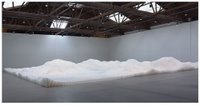
Tara Donovan’s show at PaceWildenstein, a large-scale installation of plastic cups resembling a topographical landscape, has received a lot of praise. I liked it on several levels – the sprawling scale, the element of surprise when you realize it is made up of millions of cups, the play of light. But I was curious to find out what the critics would say about something that pleases on a rather visceral level, and I think I’ve found a good example:
"Tara Donovan’s art is phenomenological [phe·nom·e·nol·o·gy: the study of the development of human consciousness and self-awareness as a preface to philosophy or a part of philosophy] in the sense that her “site responsive” [why the quotes?] sculptures reveal the purely subjective aspects of consciousness. The vacillation between illusion and material reality prevalent in her work activates perceptual shifts [Is it a bunch of cups? Is it a landscape?]. So rather than say Donovan’s “Untitled (Plastic Cups),” (2006) doesn’t work [who said it doesn’t work?] because the raw material (plastic cups) isn’t completely transformed or because we have seen this sort of thing before, we should focus on the dissociation that takes place [OK. Focusing now]. Tara Donovan’s work creates a dramatic tension between what cognitive neuroscientist Uri Hasson [here we go with the experts] calls “activation induced by local object features and activation induced by holistic, grouping processes that involve the entire object or large parts of it.” [Interesting point. What does Hasson think about the show?] Donovan would have prevented viewers from seeing her artworks close up if she wanted to conceal the individual units that comprise the whole [I don’t think there’s any question that she wants us to see the cups]. The work currently on display at PaceWildenstein is a complex version of the vase-face illusion [the who-what illusion?]. It contains an inherent contradiction in the sense that its physicality immediately inspires neuronal activation that is not dependent upon the physical properties of the visual stimulus [it makes me think I am looking at the surface of the moon and not at some cups]. It works because both ends of the spectrum, the material reality of the stacked cups and the illusion of a natural or extraterrestrial landscape, absorb our attention [that is, it is satisfying to look at, whether it’s a bunch of cups or a landscape]."
Is that clear? Good.
3 comments:
Um, there's not going to be a quiz, is there?
Oh, no! I would never pass such a test. I just hope the guy who wrote that “review” doesn’t find me.
I really like your blog; I often wonder if it's time to leave Manhattan.
It's all about edge detection I think. After all that's how we see the world, as a bunch of outlines with our brains filling in the spaces in between. The only question which method applies better here; search-based or zero-crossing based (joke).
Post a Comment